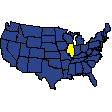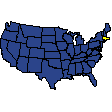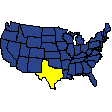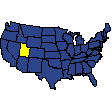State Holidays
Updated February 21, 2017 | Factmonster Staff 

Oddball Holidays
Five state holidays you may not know
| Do you have Casimir Pulaski Day off? Kids in Illinois do. Many states observe legal holidays that are specific to their history or culture and don't exist anywhere else. Here is a sampling of some of the more obscure state holidays. |
 Related Links |
Casimir Pulaski Day
On the first Monday in March, kids in Illinois get a day off from school in honor of a man who never set foot in the American Midwest.
Casimir Pulaski (1748?-1779) was a Polish native who became a war hero in two countries. In Poland, he was a leader in the effort to defend his nation against Russian forces in the 1760s and 1770s. When the defense ultimately failed to prevent the partition of Poland, Pulaski fled his country. He was eventually recruited by Benjamin Franklin to help fight against the British for American independence.
Casimir Pulaski (1748?-1779) was a Polish native who became a war hero in two countries. In Poland, he was a leader in the effort to defend his nation against Russian forces in the 1760s and 1770s. When the defense ultimately failed to prevent the partition of Poland, Pulaski fled his country. He was eventually recruited by Benjamin Franklin to help fight against the British for American independence.
Pulaski's achievements during the American Revolution, as chief of cavalry and while heading an independent legion, are recognized in Illinois each year on the first Monday of March. Illinois is home to just under one tenth of the Polish-American population.
 |
Patriots' Day
Patriots' Day, another tribute to the American Revolution, belongs to Maine and Massachusetts alone. The holiday commemorates the famous battles of Lexington and Concord.
It was on April 19, 1775, that Massachusetts minutemen, taking the cue from Paul Revere, William Dawes, and Samuel Prescott, took a stand against 700 British troops marching to Concord to raid a colonial weapons stockpile. As the militia was retreating, someone fired a weapon. This "shot heard 'round the world" marked the beginning of the American Revolution.
Patriots' Day is observed annually on the third Monday in April, with many companies allowing employees to take the day off. In addition to community celebrations, the holiday is marked by the running of the Boston Marathon.
It was on April 19, 1775, that Massachusetts minutemen, taking the cue from Paul Revere, William Dawes, and Samuel Prescott, took a stand against 700 British troops marching to Concord to raid a colonial weapons stockpile. As the militia was retreating, someone fired a weapon. This "shot heard 'round the world" marked the beginning of the American Revolution.
Patriots' Day is observed annually on the third Monday in April, with many companies allowing employees to take the day off. In addition to community celebrations, the holiday is marked by the running of the Boston Marathon.
 |
San Jacinto Day
On April 21, 1836, General Sam Houston led Texan troops in a surprise attack that sealed the future state's independence from Mexico. The location? The mouth of the San Jacinto River, near the present-day city of Houston. At least 600 of Mexican general Santa Anna's men were killed and more than 700 were taken prisoner in the 18-minute Battle of San Jacinto. Among Houston's 800 men, only nine lost their lives.
Texas pride abounds every April 21 as the state celebrates its independence from Mexico. The battle site is now adorned with a monument that, in true Texas style, was once the tallest stone monument in the world.
San Jacinto Day is one of several holidays unique to Texas. Residents also celebrate their state's colorful history on Texas Independence Day (March 2), Emancipation Day (June 19), and Lyndon Baines Johnson Day (Aug. 27).
Texas pride abounds every April 21 as the state celebrates its independence from Mexico. The battle site is now adorned with a monument that, in true Texas style, was once the tallest stone monument in the world.
San Jacinto Day is one of several holidays unique to Texas. Residents also celebrate their state's colorful history on Texas Independence Day (March 2), Emancipation Day (June 19), and Lyndon Baines Johnson Day (Aug. 27).
King Kamehameha Day
The Hawaiian Islands have a rich history of their own, having avoided European contact until the end of the 18th century and U.S. domination until the end of the 19th century.
Kamehameha the Great (c. 1738-1819) became king of the island of Hawaii in 1790 at a time when the Hawaiian islands were ruled individually and were at war with one another. By 1810, Kamehameha had gained control of all the islands and united them for the first time. Under his leadership, Hawaii became peaceful and prosperous. Kamehameha is recognized as a heroic leader who helped smooth the impact of the Western "invasion" on the Hawaiian people and culture.
Each year on and around June 11, the islands plan floral parades, hula competitions, and other festivities incorporating traditional Hawaiian cultural themes.
Kamehameha the Great (c. 1738-1819) became king of the island of Hawaii in 1790 at a time when the Hawaiian islands were ruled individually and were at war with one another. By 1810, Kamehameha had gained control of all the islands and united them for the first time. Under his leadership, Hawaii became peaceful and prosperous. Kamehameha is recognized as a heroic leader who helped smooth the impact of the Western "invasion" on the Hawaiian people and culture.
Each year on and around June 11, the islands plan floral parades, hula competitions, and other festivities incorporating traditional Hawaiian cultural themes.
 |
Pioneer Day
Pioneer Day (also called "Days of '47") is doubly significant for the large portion of Utah's population that belongs to the Church of Jesus Christ of Latter-day Saints. July 24 is the anniversary of the day in 1847 when Brigham Young reached the Salt Lake Valley and declared it the place where he and his followers would settle.
Fleeing religious persecution in their former home of Nauvoo, Illinois, the group traveled 1,300 miles to this site. These first pioneers paved the way for thousands of other Mormons and for many other people who would officially become Utahns in 1896. More than a century later, the state continues to pay tribute to its founders on July 24 each year.
Fleeing religious persecution in their former home of Nauvoo, Illinois, the group traveled 1,300 miles to this site. These first pioneers paved the way for thousands of other Mormons and for many other people who would officially become Utahns in 1896. More than a century later, the state continues to pay tribute to its founders on July 24 each year.
